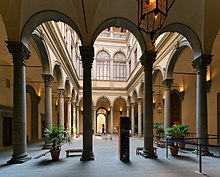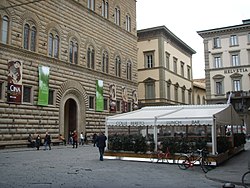Palazzo Strozzi



Palazzo Strozzi is a palace in Florence, Italy.
History
The construction of the palace was begun in 1489
The palace faces the historical Via de' Tornabuoni.
Description
Palazzo Strozzi is an example of civil architecture with its
The

The palace was left incomplete by Simone del Pollaiolo (il Cronaca), who was in charge of the construction of the palace until 1504. Also by Cronaca is the cortile or central courtyard surrounded by an arcade,[7] inspired by Michelozzo.
Wrought-iron objects known as
The palazzo remained the seat of the Strozzi family until 1937. Great changes were made to the building when the
See also

Notes
- ^ Florence: The city layout. Encyclopædia Britannica. 2007.
- ^ Goldthwaite 1968.
- ^ Heather Gregory, "The Return of the Native: Filippo Strozzi and Medicean Politics" Renaissance Quarterly 38.1 (Spring 1985), pp. 1–21.
- ^ Richard Goldthwaite, "The building of the Strozzi palace: the construction industry in Renaissance Florence" Studies in Medieval and Renaissance History 10 (1973) pp99-135.
- ^ rustication. Encyclopædia Britannica. 2007.
- ^ Amanda Lillie, Florentine Villas in the Fifteenth Century: An Architectural and Social History (Cambridge University Press) 2005:239 and fig. 195.
- ^ cortile. Encyclopædia Britannica. 2007.
Sources
- Bullard Melissa M., Filippo Strozzi and the Medici: Favor and Finance in Sixteenth-Century Florence and Rome (Cambridge) 1980.
- Goldthwaite, Richard, Private Wealth in Renaissance Florence: A Study of Four Families (Princeton) 1968.
- —, The Building of Renaissance Florence: An Economic and Social History (Baltimore) 1980.
External links
- "Palazzo Strozzi official website". Retrieved April 13, 2007.
- Matthews, Kevin (2007). "Palazzo Strozzi". The Great Buildings Collection. Artifice, Inc. Retrieved February 16, 2007.
- "Palazzo Strozzi in official website of Tourism of Tuscany".
